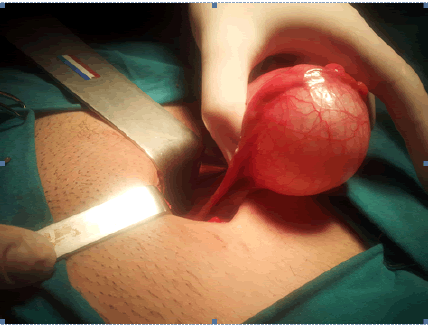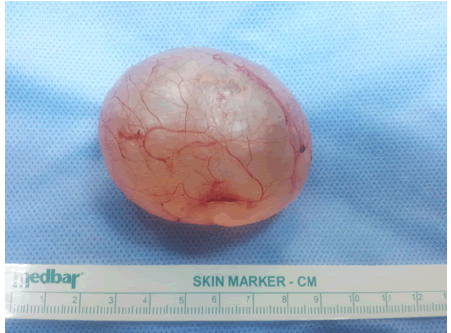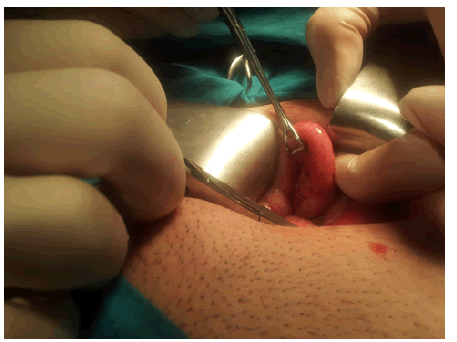Make the best use of Scientific Research and information from our 700+ peer reviewed, Open Access Journals that operates with the help of 50,000+ Editorial Board Members and esteemed reviewers and 1000+ Scientific associations in Medical, Clinical, Pharmaceutical, Engineering, Technology and Management Fields.
Meet Inspiring Speakers and Experts at our 3000+ Global Conferenceseries Events with over 600+ Conferences, 1200+ Symposiums and 1200+ Workshops on Medical, Pharma, Engineering, Science, Technology and Business
Research Article Open Access
A Paratubal Cyst Associated with Flegmonous Appendicitis: A Case Report and Review of Literature
| Volkan Sarper Erikci*, Demet Payza, Malik Ergin and Munevver Hosgor | |
| Department of Pediatric Surgery, Dr. Behcet Uz Children's Hospital, Izmir, Turkey | |
| Corresponding Author : | Volkan Sarper Erikci Cavalry Cad. Father Apt. No: 34 D.6 Bornova- Izmir 35100, Turkey Tel: 0 542 4372747 Fax: 232 4892315 E-mail: verikci@yahoo.com |
| Received date: Feb 26, 2016; Accepted date: Mar 14, 2016; Published date: Mar 21, 2016 | |
| Citation: Erikci VS, Payza D, Ergin M, Hosgör M (2016) A Paratubal Cyst Associated with Flegmonous Appendicitis: A Case Report and Review of Literature. J Preg Child Health 3:232. doi:10.4172/2376-127X.1000232 | |
| Copyright: © 2016 Erikci VS, et al. This is an open-access article distributed under the terms of the Creative Commons Attribution License, which permits unrestricted use, distribution, and reproduction in any medium, provided the original author and source are credited. | |
Visit for more related articles at Journal of Pregnancy and Child Health
Abstract
Paratubal cysts (PTCs) are remnants of paramesonephric or mesonephric ducts and mostly benign. Paraovarian and paratubal cysts are used synonymously. These masses have been reported in all age groups, beginning from premenarchial period up to menopause, but most commonly are seen in the third and fourth decades of life. A 14- year-old girl wih flegmonous appendicitis diagnosed and treated during the management of PTC is presented and discussed.
| Keywords |
| Paratubal cyst; Flegmonous appendicitis |
| Introduction |
| Paratubal cysts (PTCs) are remnants of paramesonephric or mesonephric ducts and mostly benign [1]. Paraovarian and paratubal cysts are used synonymously [2]. These masses have been reported in all age groups, beginning from premenarchial period up to menopause, but most commonly are seen in the third and fourth decades of life [2,3]. A case of flegmonous appendicitis diagnosed and treated during the management of PTC is presented and discussed. |
| Case Report |
| A 14-year-old girl had signs of acute surgical abdomen. All laboratory parameters were normal, except an increase in white blood cell count (16300/μL). In addition to a normally perfused left ovary with multiple small cysts, a pelvic Doppler ultrasonography (US) demonstrated of a cystic mass adjacent to the right ovary with a dimension of 60×50×40 mm with no perfusion. The cyst was found to be unilocular with no solid components or septations and the right ovary was not visible by US. The abdominal magnetic resonance imaging (MRI) revealed a unilocular cystic mass with no septation or mural nodule with a dimension of 64×54×43 mm consistent with a PTC (Figure 1). With the suspicion of torsion of the ovarian pedicle or fallopian tube accompanied by a PTC, the patient underwent an emergent exploration. Laparotomy by a pfannenstiel incision revealed that both of the fallopian tubes and ovaries were normal. A mass of 6×5 cm in diameter between the left fallopian tube and left ovary was found and enucleated totally preserving the adjacent ovary and fallopian tube (Figures 2 and 3). To our surprise, synchronous abdominal exploration also revealed an inflamed appendix (Figure 4). Standard appendectomy was added to the procedure. Histopathology revealed a flegmonous appendicitis and a paratubal cyst with a smooth inner surface with a thin wall. The patient had an uneventful postoperative course. |
| Discussion |
| PTCs are rare clinical entities and are believed to originate from mesothelium or be remnant of Mullerian duct and Wolffian duct [1]. Although the term paraovarian cyst is also used, generally, terminology depends on location of cyst. |
| When adjacent to fallopian tubes it is referred to as PTC. With a variable size and typically thin wall these masses may be attached to fimbriated end of tube by a pedicle. Cysts are usually small and asymptomatic (<1 to 8 cm in diameter) and most reported cases of PTCs have occured in pediatric patients [4]. PTCs may be found at surgery or incidentally on radiological study performed for another reason. Cysts may also lead to torsion of adnexa resulting in acute pain. It has been hypothesized that PTCs increase in size with hormonal activity [5]. Larger lesions may become symptomatic causing pressure or pain. An association between PTCs and obesity has also been suggested [6]. Our case was not considered to be obese because she was within the normal range of weight and height percentile. PTCs usually consist of either unciliated epithelium, ciliated cuboidal epithelium, or ciliated columnar epithelium [7,8]. Histopathological examination revealed that there was clear serous type fluid inside the cyst and epithelium was ciliated columnar type in our patient. |
| US, computerised tomography (CT) or MRI may be performed in preoperative evaluation. Sonographically a PTC is unilocular with serous fluid inside without internal echoes and has a smooth wall [9]. Due to the possibility that ovarian torsion may be also one of the differential diagnoses, pelvic Doppler US was performed in our patient. A unilocular cystic mass with no solid components or septations adjacent to the right fallopian tube was observed and there was no blood perfusion in the cystic mass. The right ovary was not visible by US. CT or MRI are the other choices of diagnostic tools in these patients. MRI findings of these paramesonephric or mesonephric remnants have been reported and it has been suggested that demonstration of a normal ipsilateral ovary close to, but seperated from, the adnexal cyst may be an important MRI finding for the diagnosis [10]. MRI finding in our case was a large unilocular cystic mass at the level of right ovary (Figure 1). Nevertheless, US and MRI findings in these patients are nonspecific and none of these imaging modalities have specific criteria for a definite dignosis. |
| Treatment options in PTCs include cystectomy, fenestration of cyst, aspiration of cyst fluid [11]. Enucleation of the PTC with an attempt of tubo-ovarian salvage should be the first choice. Preservation of fallopian tubes and ovary during excision of the cyst may increase the future reproductive potential of these children. Enucleation of the PTC was performed uneventfully in our patient. At the end of the operation abdominal exploration through the same incision revealed a striking finding- an inflamed flegmonous appendicitis- and standard appendectomy was added to the surgical procedure. |
| Literature review regarding coincidence of appendicitis with other pelvic pathologies come especially from adult cases and include various entities. These are tubal pregnancy [12-16], ovarian cyst [17], hemorrhagic corpus luteal cyst [18], bleeding ovarian follicle with hemoperitoneum [19]. Parovarian cyst torsion including rupture of the left ovary coexisting with a flegmonous appendicitis has also been reported [20]. Regarding association of appendicitis with pelvic pathologies in children, ovarian torsion is most commonly seen and there are 7 pediatric cases of ovarian torsion concurrent with appendicitis [21]. A case of supurative salpingitis in association with flegmonous appendicitis has also been reported in a 11 year-old girl [22]. To the best of our knowledge, there is no pediatric case of PTC associated with a flegmonous appendicitis in the English language literature and our case is the first child with a PTC and flegmonous appendicitis. |
| Physicians hesitate to accept the possibility of double pathology in the same patient. This reluctance stems from an experience that it is rare for occurence of two coincident pathological conditions. This case shows the importance of considering multiple pathologic disorders in a patient with an acute surgical abdomen. To our knowledge, this is the second report of a combination of PTC and flegmonous appendicitis and first pediatric case. As is shown in this case, PTC and flegmonous appendicitis can be seen together as distinct entities in children and should be kept in mind during differential diagnosis of these children. |
References
- Stenbäck F, Kauppila A (1981) Development and classification of parovarian cysts. An ultrastructural study. GynecolObstet Invest 12: 1-10.
- Kiseli M, Caglar GS, Cengiz SD, Karadag D, Y√?¬Īlmaz MB (2012) Clinical diagnosis and complications of paratubal cysts: review of the literature and report of uncommon presentations. Arch GynecolObstet 285: 1563-1569.
- Pepe F, Panella M, Pepe G, Panella P (1986) Paraovariantumors. Eur J GynaecolOncol 7: 159-161.
- Chauhan S, Blacker C (2005) Paratubal cyst: a case report. W V Med J 101: 176.
- Devouassoux-Shisheboran M, Silver SA, Tavassoli FA (1999) Wolffian adnexal tumor, so called female adnexal tumor of probable wolffian origin (FATWO): immunohistochemical evidence in support of a Wolffian origin. Hum Pathol 30: 856-863.
- Muolokwu E, Sanchez J, Bercaw JL, Haghpeykar HS, Banszek T, et al. (2011) Paratubal cysts, obesity, and hyperandrogenism. J PediatrSurg 46: 2164-2167.
- Samaha M, Woodruff JD (1985) Paratubal cysts: frequency, histogenesis, and associated clinical features. ObstetGynecol 65: 691-694.
- Drews U (2007) Helper function of the Wolffian ducts and role of androgens in the development of the vagina. Sex Dev 1: 100-110.
- Hasuo Y, Higashijima T, Mitamura T (1991) Torsion of parovarian cyst--report of two cases. Kurume Med J 38: 39-43.
- Kishimoto K, Ito K, Awaya H, Matsunaga N, Outwater EK, et al. (2002) Paraovarian cyst: MR imaging features. Abdom Imaging 27: 685-689.
- Seckin B, Ozdener T, Tapisiz OL, Batioglu SS (2011) Laparoscopic treatment of ovarian cysts in adolescents and young adults. J PediatrAdolescGynecol 24: 300-303.
- Allan NJ, Heringer R (1970) Coincident acute appendicitis and tubal pregnancy. Can Med Assoc J 103: 531.
- Hazebroek EJ, Boonstra O, van der Harst E (2008) Concurrent tubal ectopic pregnancy and acute appendicitis. J Minim Invasive Gynecol 15: 97-98.
- Kononski√?¬≠AD (1967) Acute appendicitis associated with tubal pregnancy. PediatrAkusGinekol 5: 65.
- Pelosi MA, Apuzzio J, Iffy L (1979) Ectopic pregnancy as an etiologic agent in appendicitis. ObstetGynecol 53: 4S-6S.
- Mathelier AC (1983) Tubal pregnancy coexisting with retrocecal gangrenous appendicitis. A case report. J Reprod Med 28: 45-46.
- Gavrilenko BG, Chernyshenko GA, Chernega VI (1986) Destructive appendicitis in combination with torsion of a left ovarian cyst. KlinKhir: 65-66.
- Neinstein LS, Braud BJ (1984) Coincident acute appendicitis and hemorrhagic corpus luteal cyst. J Adolesc Health Care 5: 137-138.
- Rabinovitch J, Rabinovitch P (1955) Coexisting acute appendicitis and bleeding ovarian follicle with hemoperitoneum. AMA Arch Surg 71: 178-184.
- Nikolaev VI (1971) Phlegmonous appendicitis in association with a twisted left parovarian cyst and rupture of the left ovary. VestnKhirIm I IGrek 106: 141.
- Hoey BA, Stawicki SP, Hoff WS, Veeramasuneni RK, Kovich H, et al. (2005) Ovarian torsion associated with appendicitis in a 5-year-old girl: a case report and review of the literature. J PediatrSurg 40: e17-20.
- Nikulin VG, Vesnin VA (1990) Right-side suppurativesalpingitis and secondary acute phlegmonous appendicitis in an 11-year-old girl. KlinKhir: 62-63.
Figures at a glance
 |
 |
 |
 |
| Figure 1 | Figure 2 | Figure 3 | Figure 4 |
Post your comment
Relevant Topics
Recommended Journals
Article Tools
Article Usage
- Total views: 12578
- [From(publication date):
April-2016 - Apr 01, 2025] - Breakdown by view type
- HTML page views : 11684
- PDF downloads : 894
